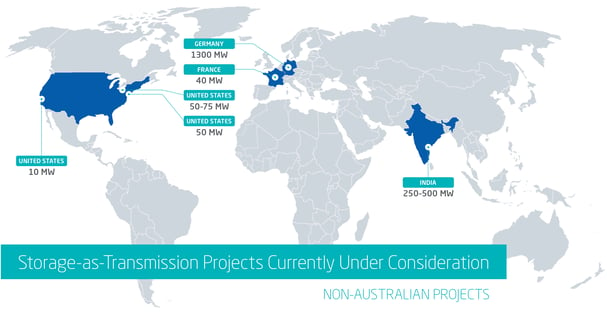Read the following contributed article as originally published on RenewEconomy:
Reworking the Grid’s Circulatory System: Storage as a Transmission Asset
Australia is poised for a transformation of its electricity system—but not in the ways you’ve heard before. In recent months, transmission companies around the world have been increasingly considering energy storage as the means to supplement a fundamental part of our electric power infrastructure: the poles and wires that carry high-voltage current from power plant to end-users. Battery-based energy storage offers a solution for adding needed capacity—“virtual transmission”—on Australia’s transmission corridors, increasing system reliability and the NEM’s ability to move power between states, on far faster timelines and at less cost than traditional infrastructure.
Congestion on Australia’s transmission network is not an issue on most people’s minds but has significant impacts across the economy. Network congestion continues to make headlines in Sydney and Melbourne during the heat of summer, when temperatures often hit 50 degrees C. Transmission lines are running at full capacity but still are not able to serve all the load during the hottest day. A single transmission line outage across the state boundary can create power price surges of $14,000/MWh or brownouts—as happened in New South Wales during August 2018, when the QLD-NSW interconnector tripped due to a lightning strike.
While several initiatives being pursued at the state and national levels aim to increase critical transmission capacity and reduce network congestion, energy storage can play—and should be considered—in helping address this specific issue.
Transmission: a road system with some highways packed, others barely used
In many markets across the world, changes in where electricity is being generated and where it needs to be sent are redrawing the network map.
Networks are shifting from the model of moving power from large clusters of centralized generation to loads—like communities being powered by the coal-fired plants in Victoria’s Latrobe Valley—to where new generation is now being spread out across the network, frequently further from load centers. Intermittent solar and wind projects are being sited where the resources are most abundant, but frequently in areas where the lines weren’t designed to accommodate those power flows. The flood of new decentralized generation—in particular solar, which follows similar generation curves—is putting the equivalent of heavy highway traffic onto smaller country roads.
Meanwhile, if a coal plant is retired for economic reasons or when it reaches the end of its life, existing transmission lines can be left with capacity to spare. Bloomberg New Energy Finance found that nearly 50 percent of Australia’s coal plants will reach their end of life between 2030 and 2040, if not taken offline beforehand.
This redrawing of the map is leading to two key trends: first, additional transmission capacity is needed on a few key transmission lines on specific areas of the grid; and second, excess transmission capacity (e.g., underutilized lines) elsewhere on the grid may become stranded assets—which won’t be needed but still have to be paid for—especially in areas where renewables in one area continue to supplant traditional large power generation sources in another.
Both of these are problematic for network companies. While the first issue means they should find ways to address transmission shortages quickly—as on the interstate transmission lines—stranded assets are a more complicated problem. If existing assets are shown to be underutilized and aren’t providing as much value as originally expected, network companies will come under greater pressure to spend capital diligently as they work to address network capacity shortage issues. Changes in generation patterns (i.e., from coal to renewables, hydro and gas) are becoming more sustained, which is increasing the risk of some transmission or distribution assets becoming stranded.
In the meantime, building a traditional poles-and-wires solution to add capacity is a long and onerous process, with timelines typically ranging from two to six years, depending on the project.
Virtual transmission: like instantly adding lanes on a highway to ease traffic
Many people, even those familiar with energy storage, see it being dispatched as a form of generation—firming renewable energy or taking the place of natural gas power plants for peaking—or as a resource for managing frequency or voltage, services provided by thermal plants prior to energy storage entering the market. However, we are seeing utilities in a variety of other markets all looking at energy storage as a source of providing transmission capacity or “virtual transmission.”
The virtual transmission concept is a little-known and deceptively simple use of storage—placing energy storage on a transmission line and operating it to inject or absorb real power, mimicking transmission line flows—essentially replacing the need for a line upgrade or new line to be built. However, using energy storage to add transmission capacity represents a completely new way to solve congestion that can enable hundreds of megawatts of capacity to be added to lines in one-half or less deployment time compared to traditional assets.
Virtual transmission projects already being proposed in Germany, France, India and the U.S.

From our work across the globe, we’ve noticed four countries outside of Australia currently considering similar innovative uses of energy storage on transmission networks:
- French utility RTE is already planning its first 40 MW “virtual transmission line” project—code-named RINGO—with the goal of increasing grid integration of renewable energy and optimizing electricity currents on its network.
- The German grid development plan, produced by all the transmission-owning utilities in the country, has proposed a massive 1.3 GW of energy storage to ensure grid stability and lower network costs.
- In India, the Andhra Pradesh Transmission Company, a public-owned utility, proposed in January 2019 between 250 and 500 MW of energy storage to add capacity on its transmission network with an innovative cost recovery mechanism that includes allocating costs between renewable developers and distribution companies that have an obligation to serve load.
- In the United States, Pacific Gas & Electric selected a 10 MW energy storage project as part of a portfolio of transmission solutions during its regional transmission planning process, the first such project chosen to provide congestion relief in U.S. markets. In addition, the U.S. PJM market—the largest power market in the world—in the last year received proposals for multiple 25-50 MW battery-based storage projects to help relieve network congestion issues.
Compared to most of these countries, Australia’s transmission grid has a unique design: a long, stringy network with few interconnectors for now. Transmission lines go from west to east to north, but do not complete the loop—meaning power can only flow both ways between South Australia and Victoria, but not between South Australia and Queensland or NSW directly. This makes managing and operating a secure system that tries to minimize cost of generation very complex. The key state interconnector lines (SA-VIC, VIC-NSW, NSW-QLD) are the ones where transmission is often constrained, leading to significant price differences between the states and blocking renewable energy from being exported from specific pockets in the country.
Providing LEGO levels of scalability and millisecond-range responsiveness
Battery-based energy storage as a transmission asset offers a wide array of advantages over traditional infrastructure:
- Adding capacity with energy storage allows transmission utilities to use existing lines more effectively without having to invest in new lines to increase capacity;
- Unlike poles and wires, battery-based energy storage is modular and can be scaled to fit the need. This is like building a side or frontage road to relieve traffic when that’s all that is needed, as opposed to wires, where the equivalent building blocks are major highways;
- Battery-based energy storage has response times in the millisecond range, which means that fewer megawatts will be needed to ensure balance on the network;
- Deploying battery-based storage—in shipping container-style enclosures or buildings similar to big box stores—is far less disruptive and therefore more attractive to communities than the massive construction projects associated with traditional wires solutions.
- Storage can be deployed in just one to two years at the 100+ megawatt scale, compared to other upgrade options that typically take a minimum of two to three years to implement.
Storage’s speed of deployment delivers significant economic value that cannot be easily dismissed. As an example, each MW unlocked on several key Australian interconnectors delivers economic value on average of AU $460 per day based on historical 2017 and 2018 price differences between the connected states (Source: Fluence analysis of AEMO data). Put another way, freeing up (or creating an additional) 100 MW capacity on this interface is equivalent to saving consumers $1.4 million per month. Deploying 100 MW of storage would take 24 months less time than traditional solutions, realizing $34 million of savings during that period. The ability to deploy solutions faster should be evaluated not as a “nice to have,” but as a “must have” in the Australian network context.
That faster speed of deployment has significant other economic implications in Australia: curtailment of renewable generation, rising temperatures stressing state interconnector lines and high natural gas prices can all add up to situations where the ability to move cheap energy is restricted and expensive gas generation must be brought into play. Adding capacity to ease energy flows on the network, especially in areas where the lines were originally designed to deliver power downstream, not upstream, can reduce curtailment and better manage voltage in areas with high renewable energy penetration.
Large pumped hydro energy storage projects cannot offer the same transmission relief. In order to use energy storage for transmission needs, it needs to be modular and able to be sited at different points in the network. The point where energy is injected and withdrawn is what determines the transmission flow in the network. Large central pumped hydro projects’ inability to be sited at specific points in the network makes them not suited for this specific application.
It’s time for Australia to start using storage for solving transmission needs
At Fluence, we have been leading the charge for years in working to advance utilities’ understanding and adoption of grid-scale energy storage on transmission and distribution networks globally. Our team delivered many of the first battery-based storage systems to add transmission or distribution reliability—including the U.S. MISO market, multiple systems in Arizona to support neighborhoods with high solar penetration, and most recently at AusNet Services’ Ballarat Terminal Station in Victoria, Australia and a Tata Power-DDL substation in northwest Delhi, India.
We are continuing to pursue these ideas in Australia working with our partners, offering a new path forward for network growth. The “virtual transmission line” is a concept whose time has come—especially in Australia, where grid conditions are changing quickly year-to-year. Deploying energy storage as a transmission resource gives Australia’s utilities an opportunity to lead the world and build a next-generation electricity network—providing new levels of network flexibility and helping ensure customers’ access to reliable, cost-effective power.
















